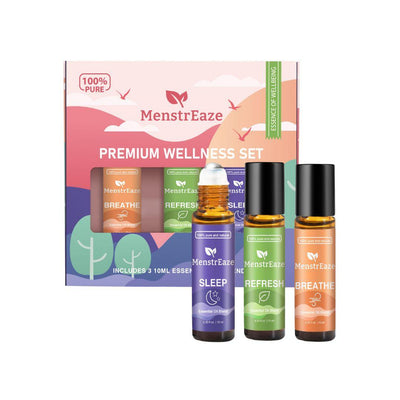This sophisticated blend combines seven potent essential oils, each contributing unique properties to support respiratory health and clear congestion. The synergistic combination addresses multiple aspects of respiratory function, from opening airways to fighting pathogens and reducing inflammation.
Eucalyptus (Eucalyptus Globulus)

Eucalyptus (Eucalyptus Globulus) serves as a cornerstone ingredient, with its high 1,8-cineole (eucalyptol) content being particularly effective for respiratory support. Studies have shown that eucalyptol helps improve mucociliary clearance, reduces inflammation in the airways, and exhibits bronchodilating properties.
Peppermint (Mentha Piperita)

Peppermint (Mentha Piperita) contains menthol as its primary active compound, which provides the characteristic cooling sensation and helps decongest nasal passages. Menthol acts on cold receptors in the nose and airways, creating a sensation of improved airflow even as it works to reduce inflammation. The bronchodilating properties of peppermint oil can help ease breathing difficulties and reduce cough symptoms.
Australian Tea Tree (Melaleuca alternifolia)

Australian Tea Tree (Melaleuca alternifolia) brings powerful antimicrobial properties to the blend. Its components, particularly terpinen-4-ol, have demonstrated effectiveness against various respiratory pathogens. This oil helps combat bacterial and viral infections that can cause respiratory congestion while supporting the immune system's natural response.
Lemon (Citrus limonum) oil

Lemon (Citrus limonum) oil contributes with its high limonene content, which has shown antimicrobial and anti-inflammatory properties. It helps break down mucus and supports lymphatic drainage, making it easier to clear congested airways. The refreshing citrus scent also provides an uplifting element to the blend.
Pine Needle (Pinus Sylvestris) oil

Pine Needle (Pinus Sylvestris) oil contains α-pinene, which exhibit expectorant properties and help clear the respiratory tract. Traditional use of pine in respiratory treatments has been supported by modern research showing its effectiveness in reducing inflammation and supporting bronchial health.
Cardamom (Elettaria cardamomum)

Cardamom (Elettaria cardamomum) adds a warming element to the blend while contributing its own respiratory benefits. Its main component, 1,8-cineole (similar to eucalyptus), helps open airways and reduce inflammation. Cardamom also has antimicrobial properties that support the blend's overall effectiveness against respiratory infections.
European Bay Laurel Leaf (Laurus nobilis)

European Bay Laurel Leaf (Laurus nobilis) completes the blend with its complex chemical profile including 1,8-cineole, linalool, and α-pinene. These compounds work together to provide antimicrobial support and help reduce respiratory inflammation.
Multi-Targeted Approach
The blend works through multiple mechanisms:
- Mucolytic Action: Breaking down and thinning mucus for easier expectoration
- Anti-inflammatory Effects: Reducing swelling in respiratory passages
- Antimicrobial Properties: Fighting respiratory pathogens
- Bronchodilation: Opening airways for easier breathing
- Immune Support: Enhancing the body's natural defenses
This combination is particularly effective because it addresses respiratory congestion through multiple pathways:
- Immediate relief through cooling and opening airways (peppermint, eucalyptus)
- Infection control (tea tree, bay laurel)
- Mucus reduction and expulsion (pine, eucalyptus, lemon)
- Sustained anti-inflammatory effects (cardamom, eucalyptus)
The scientific evidence supporting these oils' effectiveness in respiratory care continues to grow, with new studies regularly confirming traditional knowledge about their therapeutic properties. When used properly, this blend offers a natural, effective approach to managing respiratory congestion and supporting overall respiratory health.
As with any therapeutic approach, it's important to note that proper application methods should be followed, and individuals with respiratory conditions should consult healthcare providers before use, particularly those with asthma or other chronic respiratory conditions.






